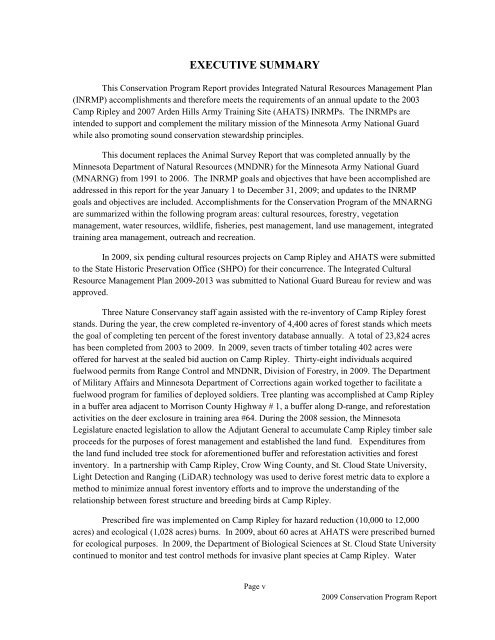camp ripley and arden hills minnesota army national guard training ...
camp ripley and arden hills minnesota army national guard training ...
camp ripley and arden hills minnesota army national guard training ...
Create successful ePaper yourself
Turn your PDF publications into a flip-book with our unique Google optimized e-Paper software.
EXECUTIVE SUMMARY<br />
This Conservation Program Report provides Integrated Natural Resources Management Plan<br />
(INRMP) accomplishments <strong>and</strong> therefore meets the requirements of an annual update to the 2003<br />
Camp Ripley <strong>and</strong> 2007 Arden Hills Army Training Site (AHATS) INRMPs. The INRMPs are<br />
intended to support <strong>and</strong> complement the military mission of the Minnesota Army National Guard<br />
while also promoting sound conservation stewardship principles.<br />
This document replaces the Animal Survey Report that was completed annually by the<br />
Minnesota Department of Natural Resources (MNDNR) for the Minnesota Army National Guard<br />
(MNARNG) from 1991 to 2006. The INRMP goals <strong>and</strong> objectives that have been accomplished are<br />
addressed in this report for the year January 1 to December 31, 2009; <strong>and</strong> updates to the INRMP<br />
goals <strong>and</strong> objectives are included. Accomplishments for the Conservation Program of the MNARNG<br />
are summarized within the following program areas: cultural resources, forestry, vegetation<br />
management, water resources, wildlife, fisheries, pest management, l<strong>and</strong> use management, integrated<br />
<strong>training</strong> area management, outreach <strong>and</strong> recreation.<br />
In 2009, six pending cultural resources projects on Camp Ripley <strong>and</strong> AHATS were submitted<br />
to the State Historic Preservation Office (SHPO) for their concurrence. The Integrated Cultural<br />
Resource Management Plan 2009-2013 was submitted to National Guard Bureau for review <strong>and</strong> was<br />
approved.<br />
Three Nature Conservancy staff again assisted with the re-inventory of Camp Ripley forest<br />
st<strong>and</strong>s. During the year, the crew completed re-inventory of 4,400 acres of forest st<strong>and</strong>s which meets<br />
the goal of completing ten percent of the forest inventory database annually. A total of 23,824 acres<br />
has been completed from 2003 to 2009. In 2009, seven tracts of timber totaling 402 acres were<br />
offered for harvest at the sealed bid auction on Camp Ripley. Thirty-eight individuals acquired<br />
fuelwood permits from Range Control <strong>and</strong> MNDNR, Division of Forestry, in 2009. The Department<br />
of Military Affairs <strong>and</strong> Minnesota Department of Corrections again worked together to facilitate a<br />
fuelwood program for families of deployed soldiers. Tree planting was accomplished at Camp Ripley<br />
in a buffer area adjacent to Morrison County Highway # 1, a buffer along D-range, <strong>and</strong> reforestation<br />
activities on the deer exclosure in <strong>training</strong> area #64. During the 2008 session, the Minnesota<br />
Legislature enacted legislation to allow the Adjutant General to accumulate Camp Ripley timber sale<br />
proceeds for the purposes of forest management <strong>and</strong> established the l<strong>and</strong> fund. Expenditures from<br />
the l<strong>and</strong> fund included tree stock for aforementioned buffer <strong>and</strong> reforestation activities <strong>and</strong> forest<br />
inventory. In a partnership with Camp Ripley, Crow Wing County, <strong>and</strong> St. Cloud State University,<br />
Light Detection <strong>and</strong> Ranging (LiDAR) technology was used to derive forest metric data to explore a<br />
method to minimize annual forest inventory efforts <strong>and</strong> to improve the underst<strong>and</strong>ing of the<br />
relationship between forest structure <strong>and</strong> breeding birds at Camp Ripley.<br />
Prescribed fire was implemented on Camp Ripley for hazard reduction (10,000 to 12,000<br />
acres) <strong>and</strong> ecological (1,028 acres) burns. In 2009, about 60 acres at AHATS were prescribed burned<br />
for ecological purposes. In 2009, the Department of Biological Sciences at St. Cloud State University<br />
continued to monitor <strong>and</strong> test control methods for invasive plant species at Camp Ripley. Water<br />
Page v<br />
2009 Conservation Program Report
















